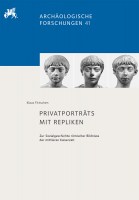Short Description
The main intention of this book is to show, that during the Roman Empire the portraits of non-imperial citizens were dublicated in the same way as the portraits of the Emperors. This is valid not only for the portraits of people of high status but for normal citizens as well. Females are represented as frequently as men, even portraits of children are not missing. These latter portraits are found especially in graves.
Description
One of the criteria for identifying a portrait of a Roman emperor has been the existence of proven ancient replicas. This rule can no longer be maintained: ancient replicas can be established also in the case of portraits of non-imperial persons. This applies not only to the portraits of members of the upper class, but also to those of more ordinary citizens. The phenomenon may be found in all parts of the Roman Empire in which portraits were produced. The portraits that can be verifiably established at present have been brought together in this volume. Some cases have been known for a long time (Herodes Atticus, Athenais, Polydeukion), although no consequences have been drawn from this by researchers. Portrait replicas were not only set up in public places: above all, graves presented an opportunity to honor the deceased with multiple portraits. A corresponding context can be established in few cases, however, as portraits from this domain were generally separated as »doublets« by art dealers. Copies made of famous ancient portraits in modern times must be excluded from the group of ancient portrait replicas. In older research some of them were regarded as ancient copies and were mistakenly associated with Roman emperors and their family members on account of their supposed replica character. It is not always very easy, however, to prove production in the modern era. The most important specimens from this category are collected in Appendix B. Appendix A, meanwhile, brings together the multiple portraits of the same person at grave altars and sarcophagi, which may be seen as classic examples of private portraits with replicas.
Series Description
In the series of “Archäologische Forschungen” (Archaeological Studies), monographs on the various areas of research in Classical Archaeology are published, mainly concentrating on studies concerning architecture, urban research, topography and everyday culture of Greece, Asia Minor, and the periphery of the Greek world. The chronological scope ranges from the beginning of periodized history to late antiquity. The following volumes, partly to be published in sub-series, will present the findings of research and excavations in the Hellenistic and Roman towns of Priene, Aizanoi and Pompeii. “Archäologische Forschungen” are edited by the Head Office of the Deutsches Archäologisches Institut (German Archaeological Institute) in Berlin.




 Preface
Preface

 Neuerscheinungen 2023/2024
Neuerscheinungen 2023/2024
 Gesamtverzeichnis 2023/2024
Gesamtverzeichnis 2023/2024
 Katalog Oriental Studies & Linguistics
Katalog Oriental Studies & Linguistics
 Mittelalter
Mittelalter
 Deutsche Inschriften
Deutsche Inschriften
 Musiktherapie
Musiktherapie
 Literaturen im Kontext
Literaturen im Kontext